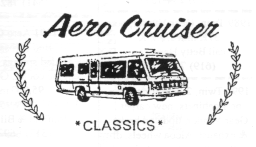Engine's Emission System Tips:
Emissions Sticker, Smog Test, Smog Pumps, EGR Valve, Oxygen Sensor.
Click on the
 to
go to its Tip: to
go to its Tip: |
 |
Emission Letter & Sticker from Vironex (High-Res. Letter to Print) |
 |
Emission Pre-Check before a Smog Test
|
 |
Emissions Sticker
|
 |
Smog Test
|
 |
Emission Control
|
 |
Smog Pumps
|
 |
Air Relief Valve on the Air Injection (Smog) Pump
|
 |
EGR Valve
|
 |
Oxygen Sensor
|
-- Disclaimer --Information
on this Web Site is provided by members of the "Aero Cruiser Classics" Motor home Club. All
information on this site is contributed by the club members or outside sources and is believed to be reliable; however,
there is no warranty or guarantee that said information or advice is correct or free of defect. It is
offered on a best effort basis and is to be used at your own risk.
Tips:
Subject:
Emission Pre-Check before a Smog Test
Tip 1:
Remember that the emission is based
on the year of the engine, not the year of the coach.
The label on the engine air cleaner indicates the
details of the emission compliance and any exceptions.
That’s where the mechanic will look first.
Newsletter dated Spring 1994 has a copy of the
letter from Vironex, Inc. explaining that Chrysler
paid penalty to introduce the engine into commerce
with higher emissions than provided by law.
The main reason engines do not pass emission test is
due to leaking vacuum lines or in case of fuel
injected engines, dripping fuel injectors. Check the
vacuum lines for damage, make sure the carburetor-
to manifold gasket is good, and run a can or two
of injector cleaner through the gas tank prior to
getting your engine tested.
Oxygen sensor is the component that often gets
overlooked. Bosch makes a replacement for our
gasoline engines.
Engine idle should be 1000 rpm in neutral and 850
in gear.
If you have two air pumps (smog pumps) and one of
them goes bad, replace both of them at the same
time.
Tip 2: It has been my experience that
the best thing you can do is to insure that you pass a smog test is to add the
proper amount of fuel injector cleaner to your gas (see instruction on the
product) to clean the gunk out of the carburetor or fuel injectors. Make
sure you run the engine a minimum of 25 miles on the highway with the cleaner
added to the gas just before you have it smogged as an engine up
to it's normal operating temperature will smog cleaner than a cold engine.
I add fuel injector cleaner to my first tank-full every time I take my rig on a
trip after it has sat for several months.
Another important thing is to have the
Oxygen sensor replaced every so often (5 to 10 years?) I had to have mine
replaced after 18 years the last time I had it smogged!  So I had to pay for the
Oxygen sensor, it's installation and a new smog test. If I had it done as
part of a tune-up it may have saved me time and money.
So I had to pay for the
Oxygen sensor, it's installation and a new smog test. If I had it done as
part of a tune-up it may have saved me time and money. See -- The Smell of Gasoline at a Traffic Light -- for additional information on your Oxygen Sensor.
See -- The Smell of Gasoline at a Traffic Light -- for additional information on your Oxygen Sensor.
While you are at it, consider having the vacuum lines,
radiator hose, belts, gas lines and other
rubber items replaced every so often as regular maintains rather then to wait
for them to fail during a smog test or on the road. They will fail
at some point; all you can control is when.
Keep on Cruisin', Tom Heald
 Return
to the Tip List. Return
to the Tip List.
Subject:
Emissions Sticker
Question: Where is the Emissions Sticker? I
need it to get it smogged.
Answer: The normal spot for the standard Emission
Sticker is on the side of the Air filter in all Aero Cruisers. There is a printable copy of an
Emission Letter from Vironex and the Emission Sticker
that addresses the emission system on
Aero Cruisers that have a 1987/8 and 1989 engines that are
exempt from catalytic converters. The model year of these Aero Cruisers
are from 1988 through 1991.
Keep on Cruisin', Tom Heald
 Return to the Tip List. Return to the Tip List.
Subject:
Smog Test
Tip: Before you go for your test, make
sure all emission equipment such as smog
pumps and catalytic converters are in place and
working OK to avoid being categorized as a
“gross polluter”. Engines built in ’88 and ’89 are
exempt from catalytic converters.
 Return
to the Tip List. Return
to the Tip List.
Subject:
Emission Control
Tip:
George Kinnison cautioned
everyone once again about reconfiguring the emission
control system if you live in California. It may keep you
from passing the emission test. Most problems in the
system are caused by poor or inoperative vacuum
(broken hoses). So, before you go for the test, check
the vacuum hoses, oxygen sensor, smog pumps, EGR
valve, PCV valve, and catalytic converter (if you have
one).
 Return
to the Tip List. Return
to the Tip List.
Subject:
Smog Pumps
Tip1:
Here’s a reminder for those of you with
smog pumps (fuel injected and carbureted engines). If a smog
pump freezes up while on a trip, just cut the belt
off and continue on. Frank Fries has been
beltless for years! He only puts it on for smog
tests. If you do change out a smog pump - do
both, the other one will probably follow shortly.
#101 Krafft
Tip2:
So what does a Smog Pump do? It adds air (oxygen) to the exhaust gases at
the exhaust manifold thus enhancing the burning process to help consume the left
over hydrocarbons.
The Smog pumps I used for my 1990 Fuel Injection (or I believe any 1987-89
engine) Aero Cruiser is a "Cardone Reman/Smog Pump"
For your 1989 Dodge Truck D350 1 ton P/U 2WD 5.9L FI 8cyl
Part Number: 32-242, 2012 Price $69.99 + core $7.00
Click
here for a Web link.
Keep on Cruisin', Tom Heald
 Return
to the Tip List. Return
to the Tip List.
Subject:
Air Relief Valve on the Air Injection (Smog) Pump
Tip:
I think this tech tip could have potential impact on all
Cruisers that have air injection systems on their 360HP
Dodge engines with catalytic converters.
Last year, I replaced both of air injection pumps
because of excessive air pump noise and chirping.
Later, a new rumbling and chirping in the engine
developed and I noticed that the right exhaust manifold
gasket was leaking and needed to be replaced. Upon
inspection at Eric’s RV Performance, the factor creating
the manifold gasket failure was diagnosed; the right
catalytic converter was fried.
It needed to be replaced. So, the manifold gasket and
both of the catalytic converters were replaced.
Problem solved? With the new $450 hi flow converters,
the 360 HP engine was very happy. But on the way
home, climbing a 6% grade incline and at about 60
miles per hour, the rumbling and chirping returned.
Back to Eric’s, this noise was being caused by one of
the relief valves on the air injection pumps.
Not to worry, this was something that I could easily
replace. Now the story really starts to get interesting.
Took me less than fifteen minutes to remove the upper
relief value, Chrysler part # 04268576.
Then off to NAPA and quickly found out they do not
carry an after market product to match.
Next by phone, to the nearest Chrysler dealer, they
had none in stock and could not order replacements,
as Chrysler was no longer manufacturing them.
Was referred to a Chrysler dealership in CA that did
have one valve in stock, however it was being held for
a customer.
The Tech Rep was very helpful, went on the Chrysler
dealer parts locator and found a total of five valves in
the country. Another telephone call to Chrysler
dealership in Mesa, AZ. Yes, they did have three in
stock. I now have two and they might have one left.
That leaves just two others remaining countrywide!
In my discussion with the Tech Rep in CA, he indicated
that if I was unable to find a replacement relief valve,
then I should take the Aero Cruiser to one of the CA
emission testing locations.
If they were unable to recommend a replacement
valve, then that engine would be “Blue Tagged” and
the emission control air pumps could be removed from
that coach.
I have replaced one of the relief valves and the
problem now appears to be resolved.
Keep in mind, your coach may be different.
#215 Stahl
 Return
to the Tip List. Return
to the Tip List.
Subject:
EGR Valve
Tip: Exhaust Gas Recirculation valve is in the
idle circuit.
 Return
to the Tip List. Return
to the Tip List.
Subject:
Oxygen Sensor
Tip:
Located in the left exhaust manifold.
Bosch part No. SG25, Car Quest No. 63972. See --
The Smell of Gasoline at a Traffic Light -- for additional information on your Oxygen Sensor.
 Return
to the Tip List. Return
to the Tip List.

|
Copyright© 1999-2016
Freelance Ink.
All Rights Reserved.
|

|
| 
